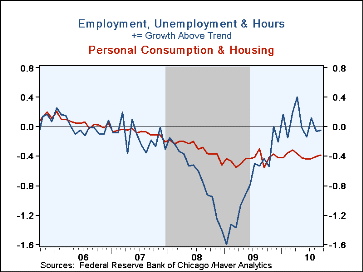 Global| Oct 25 2010
Global| Oct 25 2010Chicago Fed Index Slips Further
by:Tom Moeller
|in:Economy in Brief
Summary
In another sign of weakness in the U.S. economy, the Chicago Fed National Activity Index (CFNAI) fell further last month to its lowest level since February. Moreover, it was near its lowest level of the economic recovery. The decline [...]
 In another sign of weakness in the U.S. economy, the Chicago Fed
National Activity Index (CFNAI) fell further last month to its lowest
level since February. Moreover, it was near its lowest level of the
economic recovery. The decline to -0.58 was from an upwardly revised -0.49
during August. (Earlier figures reflect updated seasonal factors.) The
latest reading further indicated that forward momentum behind the U.S.
recovery has waned considerably. The three-month moving average of the
index, which smoothes out some of the series' volatility, held roughly
stable at -0.33, its lowest level since December.
In another sign of weakness in the U.S. economy, the Chicago Fed
National Activity Index (CFNAI) fell further last month to its lowest
level since February. Moreover, it was near its lowest level of the
economic recovery. The decline to -0.58 was from an upwardly revised -0.49
during August. (Earlier figures reflect updated seasonal factors.) The
latest reading further indicated that forward momentum behind the U.S.
recovery has waned considerably. The three-month moving average of the
index, which smoothes out some of the series' volatility, held roughly
stable at -0.33, its lowest level since December.
Since these figures remain up from the low of -3.66 reached in January '09, they still represent improvement. An index level at or below -0.70 typically has indicated negative U.S. economic growth. A zero value of the CFNAI indicates that the economy is expanding at its historical trend rate of growth. During the last ten years it's had a 78% correlation with the quarterly growth in real GDP.
The CFNAI is a weighted average of 85 indicators of economic activity. The Chicago Fed indicated that September deterioration resulted from declines in the values for production & income as well as sales, orders & inventories. The other component series were roughly flat. Month-to-month deterioration in the sub-series was balanced. Forty of the 85 individual indicators made positive contributions to the index in September, while 45 had a negative effect. The Fed also indicated that 41 indicators improved from August to September, while 44 indicators deteriorated and one was unchanged.
In a separate survey, the Chicago Fed indicated that its Midwest manufacturing index during August slipped from July which was its highest since December 2008. Indicators for the auto sectors deteriorated while others covering the steel, machinery and resource sectors improved modestly. The Chicago Federal Reserve figures are available in Haver's SURVEYS database.
| Chicago Federal Reserve Bank | September | August | July | Sept. '09 | 2009 | 2008 | 2007 |
|---|---|---|---|---|---|---|---|
| CFNAI | -0.58 | -0.49 | 0.09 | -0.65 | -1.55 | -1.85 | -0.29 |
| 3-Month Moving Average | -0.33 | -0.32 | -0.17 | -0.44 | -- | -- | -- |
| Personal Consumption
& Housing |
-0.39 | -0.40 | -0.43 | -0.56 | -0.44 | -0.29 | -0.09 |
| Employment,
Unemployment & Hours |
-0.05 | -0.06 | 0.12 | -0.43 | -0.77 | -0.67 | -0.16 |
| Production & Income | -0.17 | -0.02 | 0.26 | 0.23 | -0.21 | -0.60 | -0.05 |
| Sales,Orders & Inventories | 0.05 | -0.01 | 0.14 | 0.13 | -0.11 | -0.28 | -0.03 |
Tom Moeller
AuthorMore in Author Profile »Prior to joining Haver Analytics in 2000, Mr. Moeller worked as the Economist at Chancellor Capital Management from 1985 to 1999. There, he developed comprehensive economic forecasts and interpreted economic data for equity and fixed income portfolio managers. Also at Chancellor, Mr. Moeller worked as an equity analyst and was responsible for researching and rating companies in the economically sensitive automobile and housing industries for investment in Chancellor’s equity portfolio. Prior to joining Chancellor, Mr. Moeller was an Economist at Citibank from 1979 to 1984. He also analyzed pricing behavior in the metals industry for the Council on Wage and Price Stability in Washington, D.C. In 1999, Mr. Moeller received the award for most accurate forecast from the Forecasters' Club of New York. From 1990 to 1992 he was President of the New York Association for Business Economists. Mr. Moeller earned an M.B.A. in Finance from Fordham University, where he graduated in 1987. He holds a Bachelor of Arts in Economics from George Washington University.








